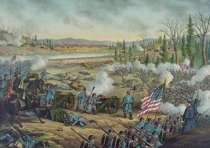
This bloody fight near Murfreesboro saw more casualties than any other Tennessee battle, though there was no clear winner. Bragg eventually retreated, allowing Rosecrans to claim victory.
By the last days of December 1862, the Civil War was more than halfway through its second year, and certainly its course had turned against the Confederacy. Yet despite the many losses, missed opportunities, and disappointments, the Confederates still exhibited a fighting spirit. Determined to overcome, they stood on the eve of another great battle as the end of December drew nigh.
The Union's Army of the Cumberland, some 44,000 strong and commanded by Major General William S. Rosecrans, was drawn up about 30 miles southeast of Nashville. Positioned along the banks of the west fork of Stones River near the small town of Murfreesboro, it faced Braxton Bragg's 38,000-man Army of Tennessee. Early on the morning of December 31 the Confederate Corps of Lieutenant General William J. Hardee struck first, and surprised Major General Alexander M. McCook's troops, still at breakfast. Hardee's corps forced the Federals to retreat some two and one-half miles to the Nashville Turnpike and railroad.
The fiercest fighting of the day came at the angle of the Union line in a dense four-acre thicket of cedars known locally as the Round Forest and afterward dubbed "Hell's Half-Acre" by soldiers who struggled there. Federal troops held the critical ground that covered both the turnpike and the railroad, and the Confederates lost another opportunity for triumph.
Both armies spent New Year's Day reorganizing and preparing to renew the battle, which they did on January 2 with heavy casualties but still no clear victor. The next day General Rosecrans held his position, and that night Bragg decided to retreat, withdrawing along the Nashville and Chattanooga Railroad for some 30 miles to Tullahoma.
Total casualties for both sides reached an estimated 24,645. No other Tennessee battle quite equaled that figure for casualties, although a few hundred more men died at Shiloh than at Stones River. The Confederate retreat left the Union forces in possession of the battlefield, and General Rosecrans claimed Stones River as a Federal triumph, a claim quickly accepted in Washington, D.C.
Tools
Key Facts
- More casualties than any other Tennessee battle: 24,645.
- The fiercest fighting took place in Hell's Half-Acre, a dense cedar thicket.
- Federals were able to hold both the turnpike and the railroad.




